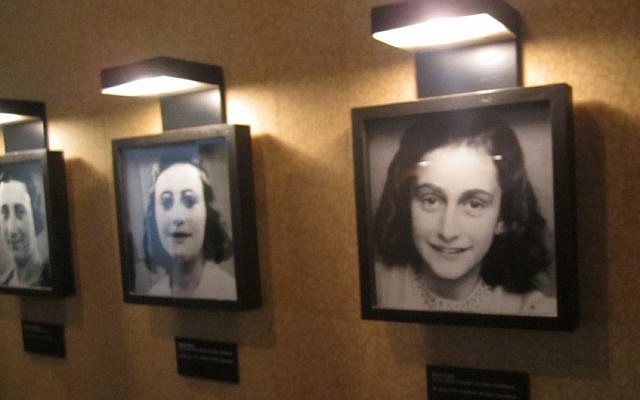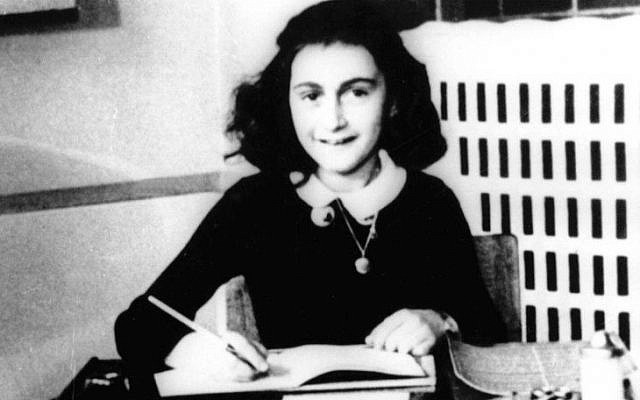Sister of Otto Frank’s typist may have betrayed Anne Frank
In new book, ‘Silence No More,’ nephew of Nelly Voskuijl posits she was a Nazi collaborator who revealed family’s Amsterdam hideout
A Dutch author published a book acknowledging that his aunt may have told Nazi authorities where to find Anne Frank and her family.
The allegation appeared in a biography that was published Tuesday about the Dutch resistance activist Elisabeth “Bep” Voskuijl.
The book, coauthored by Voskuijl’s son and the Flemish journalist Jeroen De Bruyn, explores the possibility that one of Elisabeth Voskuijl’s sisters, Nelly, was a Nazi collaborationist who may have revealed the whereabouts of the hideout where her sister was helping the Franks hide.
Elisabeth Voskuijl was a typist who worked for Otto Frank, Anne’s father, and helped the resistance fighter Miep Gies care for the Franks during their two years in hiding.
The information about Nelly Voskuijl came from testimonies by another sister, Diny, and Bertus Hulsman, who was Elisabeth Voskuijl’s fiance during the war.
According to the new book, Nelly Voskuijl served as a Nazi collaborator for four years, until she was 23.
“The painful but evident conclusion is that we can add her to the long list of suspects” in the betrayal of the Franks to the Gestapo, the authors wrote in the Dutch-language book titled “Bep Voskuijl, Silence No More.”
The identity of the person who gave up the Franks has remained a mystery that prompted much speculation after the 1947 publication of Anne Frank’s wartime diary, which she wrote among other works during her two years in hiding in Amsterdam.
An international best-seller, the diary made her one of the world’s best-known Holocaust victims.
Elisabeth Voskuijl died in 1983 at the age of 63 from kidney disease.
Though she generally declined to give interviews about her time in the resistance, she remained in contact with Otto Frank – the only member of the family to have survived the Holocaust – after the war. Nelly Voskuijl died in 2001.
Last week, it was revealed that Anne Frank likely died of typhus in a Nazi concentration camp about a month earlier than previously thought.
The Amsterdam museum that honors her memory made the announcement last Tuesday, on the 70th anniversary of the officially recognized date of her death. This finding, researcher Erika Pins said, dispels the notion that she might have been rescued had she lived a little longer.
Anne likely died, aged 15, at Bergen-Belsen camp in February 1945, said Prins, a researcher at the Anne Frank House museum.
The new date of her death changes little about the tragic lives of Anne and her sister Margot, who went into hiding with their family in an Amsterdam canal house but were eventually betrayed, sent to Nazi concentration camps and died in the Holocaust along with millions of other Jews.
‘When you say they died at the end of March, it gives you a feeling that they died just before liberation. So maybe if they’d lived two more weeks …,’ Prins said, her voice trailing off. ‘Well, that’s not true anymore’
“It was horrible. It was terrible. And it still is,” Prins said.
But she said the new date lays to rest the idea that the sisters could have been rescued if they had lived just a little longer.
“When you say they died at the end of March, it gives you a feeling that they died just before liberation. So maybe if they’d lived two more weeks …,” Prins said, her voice trailing off. “Well, that’s not true anymore.”
Allied forces liberated the Nazis’ Bergen-Belsen concentration camp on April 15, 1945.

The earlier March 31 date of Anne’s death was set by Dutch authorities after the war, based on accounts suggesting she and her sister died sometime in March. At the time, Dutch officials did not have the resources to establish an exact date.
The new research studied existing eyewitness accounts, documents and archives, including at least one new interview. Witness accounts said Anne and her sister already showed signs of typhus in early February. Researchers cited Dutch health authorities as saying most typhus deaths happen around 12 days after the first symptoms.
“In view of this, the date of their death is more likely to be sometime in February. The exact date is unknown,” the researchers said.
In the words of one witness, Rachel van Amerongen, who knew the Frank sisters and was cited by researchers, “one day they simply weren’t there anymore.”New research by the Anne Frank House in Amsterdam shows that the teenage diarist died earlier than previously believed.
The exact date of Anne Frank’s death from typhus in Bergen-Belsen concentration camp is unknown.
At the end of World War II the Red Cross officially concluded that she died sometime during March 1945.
The researchers used the archives of the Red Cross, the International Tracing Service in Bad Arolsen, and the Bergen-Belsen Memorial, in addition to as many eyewitness testimonies of survivors as possible, according to a statement from the Anne Frank House, published Tuesday on the 70th anniversary of the official date of the sisters’ deaths set by Dutch authorities after the war.
AP contributed to this story.













